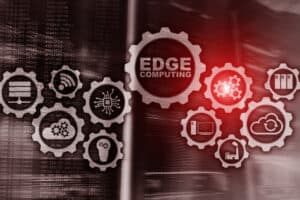
Dell offers a range of compute, storage hardware, cloud, and security solutions, as well as a platform for handling the vast amount of streaming data edge devices can produce.
Edge computing has the potential to change many industries. But to do that, businesses need ways to manage, analyze, and secure the vast amounts of streaming data coming from edge devices. RTInsights recently sat down with Jay Limbasiya, a former data scientist who leads Global AI & Data Science business development for Dell Technologies, to talk about edge data management challenges and solutions that can help convert that data into valuable, actionable insights.
Here is a summary of our conversation:
RTInsights: What are the major data management challenges organizations face when embracing edge computing and analysis of edge data?
Limbasiya: When organizations embrace edge computing and analysis of edge data, there are several challenges.
First, there is data security. Edge computing involves processing data closer to the source, which means that sensitive data may be at risk of exposure. Organizations need to ensure that the edge devices are secure and the data is encrypted and protected from unauthorized access – both in motion and at rest.
Next, there is the issue of data volume. Edge devices generate a large volume of data that needs to be processed and stored. Organizations need to ensure that they have the necessary infrastructure and resources to handle this data volume as well as a process in place for identifying what data is valuable enough to keep for particular periods of time so that they are not keeping unnecessary data longer than they need to as data volume multiplies.
Another issue is data latency. Edge computing involves processing data in real time, which means that there is little room for latency. Organizations need to ensure that their edge devices can process and analyze data quickly and efficiently.
Businesses also need to be concerned with data quality. The data generated by edge devices may be incomplete or inaccurate, which can affect the accuracy of analysis and decision-making. Organizations need to ensure that the data is of high quality and that there are processes in place to identify and address data quality issues quickly. The velocity of data from edge devices can quickly distort results if the device is not functioning properly.
Data integration is another challenge. Edge computing involves processing data from multiple sources, which may require integrating data from different systems and devices. Organizations need to ensure that their data integration processes are seamless and that the data is standardized and consistent.
Then there is data governance. Edge computing involves processing data in decentralized environments, which can make it challenging to manage data governance. Organizations need to ensure that they have policies and processes in place to ensure the privacy, compliance, and ethical use of data.
RTInsights: What type of technologies help?
Limbasiya: There are several types of technologies that can help organizations overcome the major data management challenges they face when embracing edge computing and the analysis of edge data. These include:
- Security technologies such as firewalls, intrusion detection and prevention systems, and encryption to protect edge devices and data.
- Edge computing platforms can handle large volumes of data, process data in real time, and provide low-latency analysis.
- Artificial intelligence (AI) and machine learning (ML) technologies to analyze data and detect patterns and anomalies.
- Data quality and data governance technologies, such as data cleansing, data profiling, and data lineage tools, ensure that data is of high quality and that data privacy, compliance, and ethical use of data are maintained.
- Data integration technologies such as data virtualization and data federation tools to integrate data from multiple sources and provide a unified view of data.
- Multi-cloud technologies that integrate with on-prem storage and cloud analytics to enable organizations to store and process large volumes of data in a scalable and cost-effective way.
- Edge-to-core-to-cloud orchestration technologies that can help manage the flow of data between edge devices, the data center, and the cloud; enabling organizations to leverage the benefits of both edge computing and cloud computing.
RTInsights: What solutions does Dell Technologies offer in this space?
Limbasiya: Dell offers a range of compute, storage hardware, cloud, and security solutions, as well as a platform for handling the vast amount of streaming data edge devices can produce. Some of the primary edge benefits we provide include:
- High-performance processing capabilities and support for a wide range of edge workloads via Dell PowerEdge servers and Edge Gateways.
- Scalable and flexible storage solutions for edge environments, as well as data protection and disaster recovery capabilities via Dell PowerStore and PowerScale storage systems.
- Data ingestion, storage, and analysis for large volumes of data with low-latency analysis in real time via the Dell Streaming Data Platform.
- Unified storage solutions for edge-to-core environments, enabling organizations to manage and protect data across distributed locations via Dell Unity XT.
- A range of cloud solutions that can be deployed on-premises or in the cloud, providing flexibility and scalability to meet changing business needs using Dell Technologies Cloud.
- Flexible and consumption-based models for deploying IT infrastructure, enabling organizations to easily scale up or down as needed with Dell Technologies APEX.
- Data backup and recovery capabilities for edge environments, ensuring data is protected and can be recovered in the event of a disaster using Dell Data Protection solutions.
- Consulting, implementation, and support services to help organizations design, deploy, and manage edge environments, as well as optimize data management strategies through Dell Technologies Services.
Additionally, we recently announced Project Frontier to help accelerate edge deployments for customers who get stuck on this challenge. Project Frontier is an industry-agnostic, open software platform designed to work with any OT Software/IoT framework, device, or system. It is designed as a “plug and play” solution, making it easy for customers to use.
And finally, to help customers throughout the journey, there is Dell Data Management, which is a portfolio that Dell recently began investing in. So far, we have announced solutions with partners such as Starburst, Teradata, and Snowflake.
See also: Project Frontier Seeks to Simplify Edge Operations, Optimize Investments, and Secure the Edge
RTInsights: We all know edge and edge analytics are complex environments, and there is no single end-to-end solution for all uses. As such, what roles do Dell partners play?
Limbasiya: Dell partners such as Starburst, NVIDIA, and others play a key role in enabling customers to deploy end-to-end solutions for edge computing and analytics. These partners bring expertise and capabilities in specific areas, which complement Dell’s own offerings and help customers address the complex challenges associated with edge computing and analytics.
For example, Starburst is a partner of Dell Technologies in the data analytics space, and they provide a distributed SQL query engine that enables organizations to query data from multiple sources in real time. This capability complements Dell’s storage and server solutions, which provide the optimal infrastructure foundation for the unmatched scalability, performance, resilience, and economics needed for a project of this size to run effectively.
NVIDIA, on the other hand, provides high-performance computing solutions and hardware-accelerated AI capabilities that enable organizations to process large volumes of data at the edge. NVIDIA’s technology complements Dell’s offerings by providing additional compute capabilities for edge workloads, such as computer vision, machine learning, and deep learning. Without Dell’s leading storage portfolio, the speed and data needed for this solution would not be possible.
Other Dell partners provide complementary capabilities in areas such as data management, security, networking, and software development. By working with these partners, Dell can offer customers a broader range of solutions for edge computing and analytics and help customers overcome the complex challenges associated with deploying and managing edge environments.
Also, since we focus so much on partnerships in order to bring our customers solutions for their biggest data challenges, we’ve recently launched the Dell Edge Partner Certification Program. This program enables software partners and system integrators to easily test and certify their solutions on Dell technology to simplify the deployment of new solutions and provide even greater choice for our customers.
RTInsights: What are some use cases that demonstrate how Dell Technologies is helping companies in the edge computing and edge data analytics space?
Limbasiya: There are many industries that are trying to make use of edge in their operations. Each has different computing and analytics requirements. The breadth of our offerings lets us meet the specific needs of each use case. Some examples include:
- Energy: In the energy industry, Dell Technologies is helping companies deploy edge computing solutions to monitor and manage assets in real time. For example, a utility company might use Dell’s edge computing and analytics solutions to monitor the health of its power grid, identify potential issues, and prevent downtime.
- Manufacturing: In the manufacturing industry, Dell Technologies is helping companies improve production efficiency and reduce downtime through real-time analytics at the edge. For example, a manufacturer might use Dell’s edge computing solutions to monitor equipment health, identify potential issues, and optimize maintenance schedules.
- Healthcare: In the healthcare industry, Dell Technologies is helping providers improve patient outcomes and reduce costs through real-time data analytics at the edge. For example, a hospital might use Dell’s edge computing and analytics solutions to monitor patient vital signs, identify potential health risks, and optimize treatment plans.
- Retail: In the retail industry, Dell Technologies is helping companies improve the customer experience and optimize store operations through real-time analytics at the edge. For example, a retailer might use Dell’s edge computing solutions to monitor customer traffic patterns, identify popular products, and optimize store layouts.
- Transportation: In the transportation industry, Dell Technologies is helping companies improve safety and reduce costs through real-time analytics at the edge. For example, a transportation company might use Dell’s edge computing and analytics solutions to monitor vehicle performance, identify potential maintenance issues, and optimize routes to reduce fuel consumption.
Overall, Dell Technologies is helping companies across a range of industries deploy and manage edge computing and edge data analytics solutions to improve efficiency, reduce downtime, and gain real-time insights into their operations.
Read more about Dell solutions for the edge.







